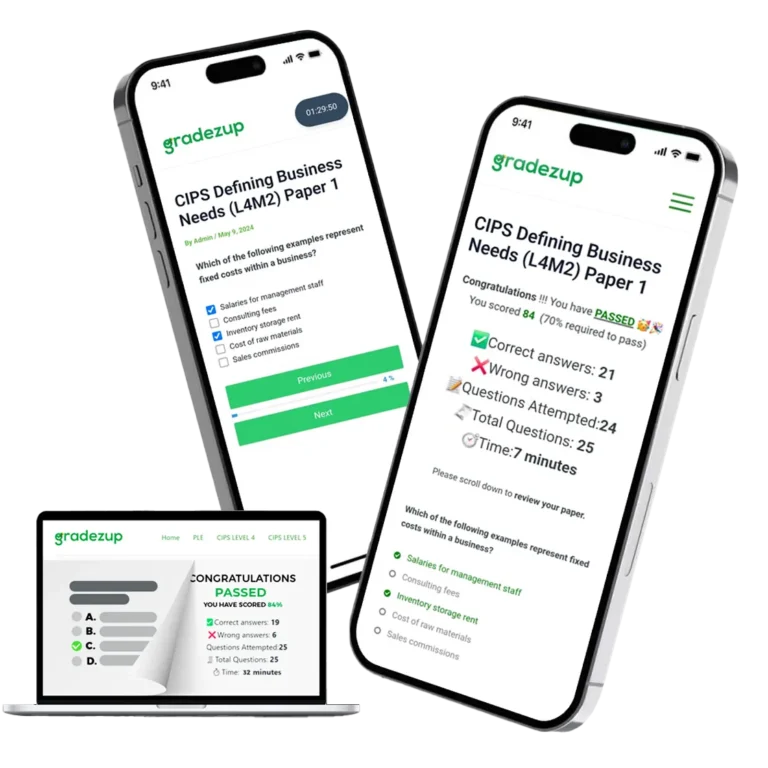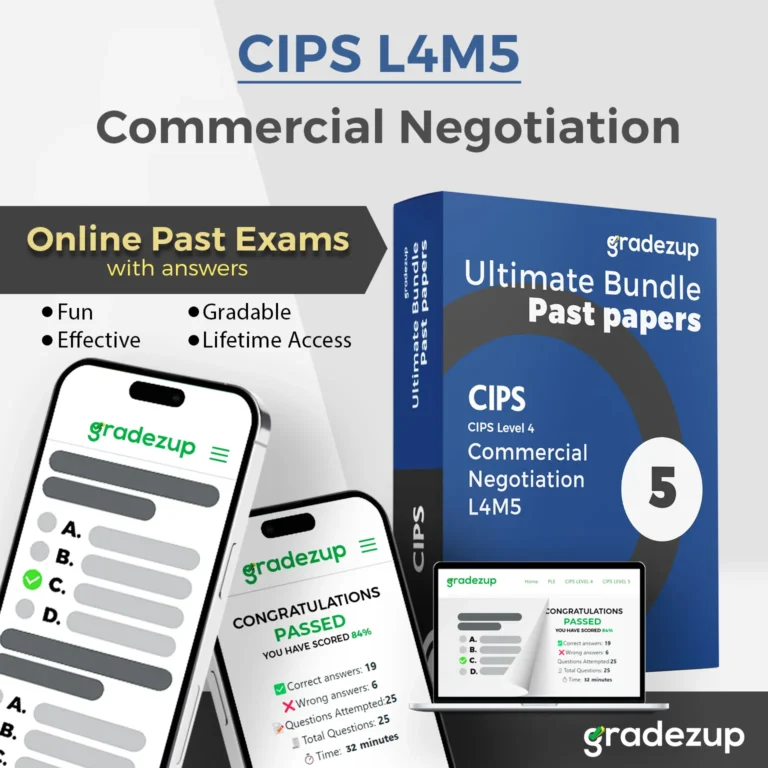
Ready to excel in your CIPS L4M5 Exams

Time's up

Time is Up!
 Access more CIPS L4M5 Exam past papers
Access more CIPS L4M5 Exam past papers 
✨ Premium Access ✨
Note: $4.99 grants you access to all papers (paper 1 – paper 12)
Gain access using
Practice Gradezup Pass L4M5 Exams
L4M5 Past Exams
L4M5 Quick Exam-Ready Summary:
- Core Module
- Objective / Response Exam
- 1.5 hours Exam duration
- 60 Questions in exam
- 6 Credits Score
Negotiation Approaches
Collaborative vs. distributive, power dynamics, relationship building
Preparation
Cost/pricing methods, economic factors, BATNA, ZOPA, resources coordination
Negotiation Conduct
Negotiation stages, behavioural dynamics, persuasion tactics
Communication Skills
Questions, listening, non-verbal communication, emotional & cultural intelligence
Reflection & Improvement
Evaluating outcomes, identifying learning points, improving future performance
CIPS L4M5 Focus Areas – 2025 (Master List)
“These are core learning areas, but CIPS may include questions from other parts of the syllabus.” ⚠️
1. Key Approaches in Commercial Negotiation
- Negotiation as a strategic process in procurement and supply.
- Approaches: collaborative/integrative vs. distributive.
- Balance of Power: its impact on outcomes.
- Relationship Dynamics: how reputation, trust, and relationship types influence negotiation Scribd, Diploma Assignment Help UK.
2. Preparation for Negotiations
- Costs & Pricing: direct vs. indirect, fixed vs. variable costs.
- Economic Analysis: break-even and cost–volume–profit (CVP) formulas.
- Costing Methods: absorption, variable/marginal costing, activity-based costing (ABC).
- Pricing Factors: understanding volumes, margins, and mark-ups.
- Economic Influences: stakeholders must consider both micro and macroeconomic factors, including market types and environments CIPS Distance Learning, Diploma Assignment Help UK.
- Negotiation Criteria: set clear objectives, BATNA (Best Alternative to a Negotiated Agreement), ZOPA (Zone of Potential Agreement), bargaining mix, and clarify positions vs. interests.
- Logistics & Resources: selection of negotiation location, assembly of the negotiation team, and consideration of alternatives to face-to-face negotiations CIPS Distance Learning.
3. Conducting the Negotiation Process
- Stages of Negotiation: preparation, opening, testing, proposing, bargaining, agreement, and closure.
- Behavioural Dynamics: how actions and perceptions shift through each negotiation stage (e.g., framing biases at the start, evolving proposals mid-way, and traps to avoid at closure).
- Persuasion & Tactics: differentiation between push vs. pull techniques; use of influence strategies such as hard/soft approaches, ‘salami slicing’, ‘broken record’, outrageous initial demands, etc. Scribd.
4. Communication Skills & Cultural Intelligence
- Questioning Techniques: open, closed, probing, reflective.
- Active Listening & Emotional Intelligence (EI): harnessing awareness of tone, empathy, and self-control.
- Push vs. Pull Communication: directive persuasion vs. collaborative engagement.
- Non-Verbal Communication: body language, eye contact, gestures.
- Cross-Cultural Awareness: adapting negotiation style to cultural norms and practices.
- Emotional Intelligence Applications: managing emotional cues to enhance outcomes Scribd.
5. Post-Negotiation Reflection & Improvement
- Reflection Process: assessing performance both during and after negotiation.
- Opportunity Identification: recognizing areas of strength and areas to improve.
- Performance Development: using reflection insights to refine future negotiations CIPS Distance Learning.
View more CIPS Exams
Select the Exams you want to practice

